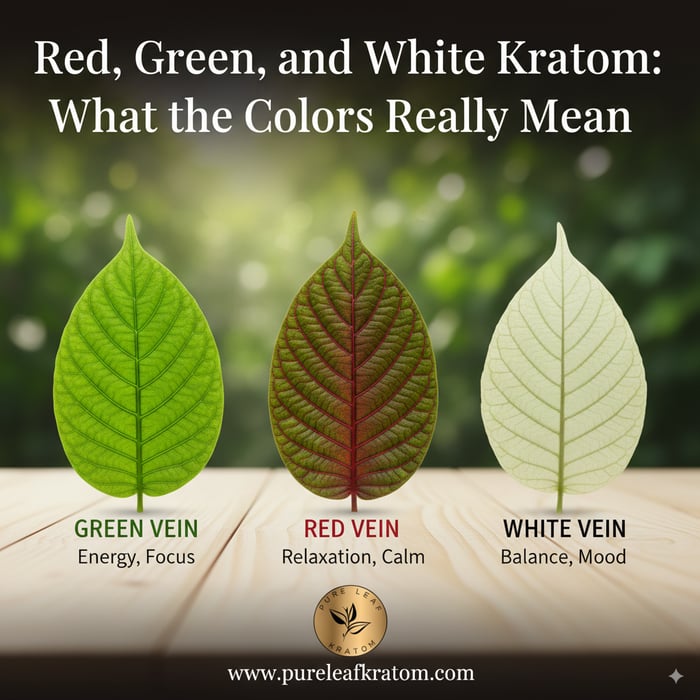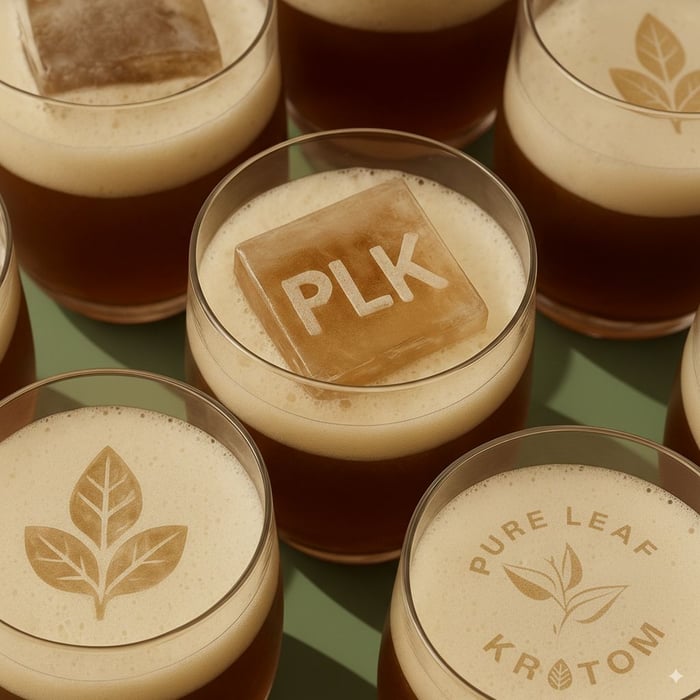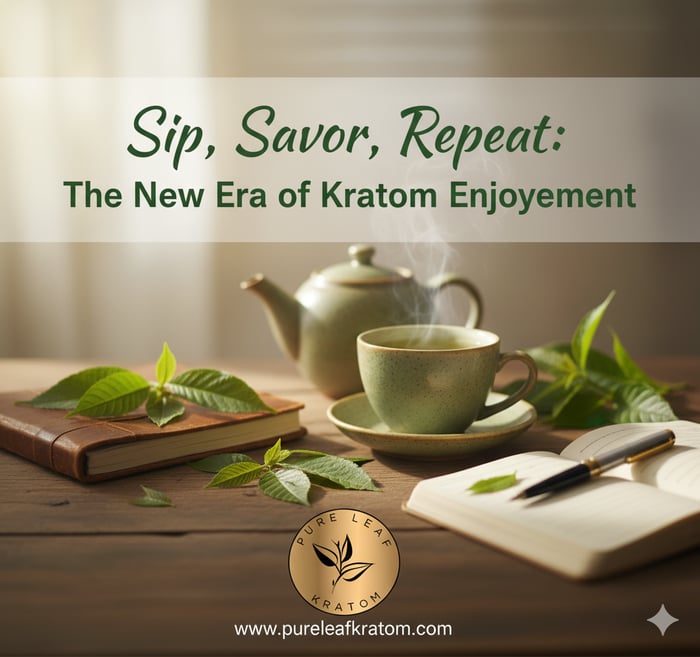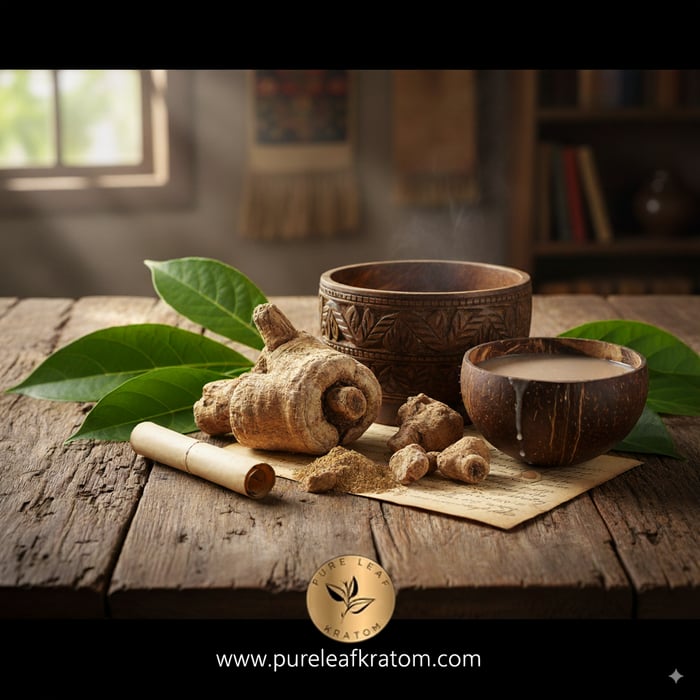- Announcements
- Features
- Kratom Buying Guide
- References
- Reviews
- Tips
- Kratom
- Kava
- Delta
- Mushrooms
- Knowledge

Red, Green, and White Kratom: What the Colors Really Mean
 Michelle Davis
Kratom Buying Guide | Kratom | Knowledge
Michelle Davis
Kratom Buying Guide | Kratom | Knowledge
10/03/2025 8:00am
16 minute read
Table of Contents
- Understanding the Origins of Kratom Colors
- Red Vein Kratom: The Grounded Classic
- Green Vein Kratom: The Balanced Middle
- White Vein Kratom: The Uplifting Pick
- Beyond the Basics: Specialty and Blended Kratom
- How to Choose the Right Kratom Color
- Kratom Color Myths and Misconceptions
- Sourcing Kratom by Color: What to Look For
- Conclusion: A Colorful World of Possibilities
- FAQs
Kratom Colors Explained: What Red, Green, and White Actually Mean
When exploring the vibrant world of kratom, one of the first things you’ll notice is the color classification: red, green, and white. These color labels aren’t just decorative, nor are they limited to branding, flavor, or packaging aesthetics they represent something much deeper. Each color points to specific differences in the way the leaves are harvested, how mature the leaves are at the time of picking, and how they’re dried and processed. These natural variations influence the plant's overall composition, resulting in distinct characteristics that set each color apart.
Rather than being a simple category system, kratom colors such as red, green, and white provide insight into the plant’s journey from tree to powder. The color of the vein, the drying environment, and even the amount of sunlight involved can all play a role in shaping the final product. For new users and seasoned enthusiasts alike, understanding what these colors signify can be the key to choosing a product that aligns with their routine, rhythm, and personal preferences.
In this comprehensive guide, we’ll explore everything you need to know about red, green, and white kratom from how the colors are determined to what each variety typically offers in terms of aroma, appeal, and overall profile. Whether you're just starting out or looking to expand your kratom knowledge, this breakdown will help you better appreciate the significance behind the colors and what they truly mean.
Understanding the Origins of Kratom Colors
Before we dive into the individual colors, it's essential to understand where these classifications come from and why they matter. The red, green, and white kratom labels aren't just arbitrary names they’re rooted in the plant’s biology and how it is processed after harvest. Each of these colors red, green, and white reflects a specific stage in the leaf’s development and a distinct post-harvest treatment. Understanding the foundation of kratom color classification gives you the tools to better interpret strain names, identify quality products, and explore new varieties with confidence.
1. Leaf Vein Color
Kratom (Mitragyna speciosa) leaves naturally display different vein colors red, green, and white depending on their age, stage of development, and exposure to environmental conditions. While the outer part of the leaf remains green, the vein running through its center can shift to red, green, or white. This change is part of the plant’s natural maturation process and reflects the internal development of the leaf’s unique composition.
Red-vein kratom comes from the most mature leaves, often found lower on the tree and picked later in the harvesting cycle. These leaves have developed their full color, and their deeper hue is a sign of their age and readiness.
Green-vein kratom is typically harvested midway through the plant’s growth cycle. The veins have shifted from white to green, indicating they’ve reached a stage of balance not too young, not fully matured.
White-vein kratom comes from the youngest leaves, harvested early before the veins darken. These are often located near the top of the plant where new growth occurs and are considered the freshest leaves in terms of age.
Vein color is influenced by several environmental factors as well, including sunlight exposure, rainfall, soil composition, and seasonal climate changes. Even leaves from the same tree can show variations in color depending on where they grow and how much light they receive. Although the color may fade after drying and grinding, the vein color at harvest remains the basis for categorizing the product.
2. Post-Harvest Processing
Once the leaves are harvested, the way they’re handled plays a major role in defining their final color and character. Drying, fermenting, and storage techniques all influence the appearance and profile of the kratom.
Red-vein leaves are commonly fermented or exposed to direct sunlight for an extended period. This encourages deeper oxidation, enriching the leaf’s reddish tone and earthy qualities. Some red strains undergo multiple drying phases, including sun-drying followed by indoor curing to lock in their richness.
Green-vein kratom is generally dried indoors under partial light. This careful process helps preserve the leaf’s green hue and ensures the final powder retains its balance between brightness and depth. The drying time and conditions are carefully managed to prevent excessive oxidation.
White-vein kratom is typically dried indoors in dark, controlled environments. This protects the leaf from light and oxidation, helping it maintain its lighter appearance and fresher characteristics. The goal is to keep the profile crisp and clean.
Each post-harvest method contributes to the subtle differences between batches, even within the same color group. That’s why reputable kratom vendors often work closely with farmers to maintain consistent drying practices and ensure product quality.
Red Vein Kratom: The Grounded Classic
Red vein kratom is one of the most widely recognized and consistently popular types on the market. Known for its deep reddish-brown color and robust, earthy aroma, red vein strains have earned their reputation as foundational staples in nearly every kratom collection.
Visual and Physical Characteristics
Red vein kratom powders typically have a darker appearance, often a mix of deep green and brown tones with hints of maroon depending on how they’ve been processed. This color is the result of both the natural vein hue and the fermentation or sun-drying methods applied during production. The texture is often fine and dense, with a rich, herbal scent that reflects its maturity.
Harvesting and Drying
Red vein leaves are picked later in the plant’s life cycle, giving them time to reach full maturity on the tree. These mature leaves are then often fermented in breathable bags or dried directly under sunlight. Some farmers use a combination of both techniques to enhance the plant’s natural characteristics. Moisture, airflow, and light exposure are all carefully controlled to ensure consistency in both color and overall quality.
Popular Red Vein Strains
Red strains are commonly associated with smooth, full-bodied profiles that make them an appealing choice for those who enjoy a more grounded kratom experience. Among the most sought-after red strains are:
Red Bali – A go to choice for beginners and veterans alike, Red Bali is celebrated for its depth and accessibility. It’s often viewed as a dependable daily strain.
Red Maeng Da – Known for its boldness and consistency, Red Maeng Da is one of the strongest and most popular red vein varieties. Its rich aroma and powerful profile have made it a best-seller in many kratom stores.
Red Borneo – Often described as smooth, Red Borneo is favored for its more mellow and rounded character. It’s a solid pick for evening routines or winding down.
Many people include red strains in their rotation as part of a balanced kratom collection. Whether used on their own or blended with other colors, reds offer depth, maturity, and reliability.
Green Vein Kratom: The Balanced Middle
Green vein kratom is often described as the “middle ground” between red and white varieties. It’s a versatile choice that appeals to a wide range of users due to its balanced nature. If red is deep and grounding and white is bright and energetic, green kratom falls right in between offering elements of both without leaning too far in either direction.
Visual and Physical Characteristics
Green kratom powders tend to have a rich, mossy green appearance, often with a fresh and slightly grassy aroma. The texture is fine and smooth, and the color reflects both the natural vein pigmentation and the controlled indoor drying process used to preserve its freshness. It strikes a visual balance between the darker reds and the pale whites.
Harvesting and Drying
Green vein leaves are harvested when the plant is at a mid-point in its life cycle not young, not fully mature. At this stage, the veins in the leaves have turned from white to green, and the alkaloid content is developing into a well-rounded profile. Farmers typically dry green kratom leaves indoors under indirect light or with fans, a process that retains their green hue and keeps the final product clean and balanced.
The drying environment plays a critical role in ensuring the leaf doesn’t oxidize too much, which could darken the color or shift the chemical profile. The result is a product that reflects the plant’s natural equilibrium a little bit of energy, a little bit of calm, and a lot of flexibility.
Popular Green Vein Strains
Green strains are some of the most frequently used because of their adaptable qualities. Whether you’re new to kratom or looking for a dependable everyday option, green varieties offer something for almost everyone. Some standout strains include:
Green Malay – Renowned for its smooth, long-lasting experience and vibrant character, Green Malay is a fan favorite among experienced users.
Green Maeng Da – A strong and reliable strain, Green Maeng Da blends a balanced aroma with a bold profile, making it an excellent daytime companion.
Green Thai – Known for its subtle fragrance and traditional roots, Green Thai is a great example of a well-rounded green vein option.
Green kratom is especially popular for its versatility. It fits seamlessly into morning, midday, or early evening routines and is often blended with other strains to enhance complexity. Many users rely on green strains as their daily go-to because of their natural harmony and consistency.
White Vein Kratom: The Uplifting Pick
White vein kratom is often selected by those looking for a fresh, light experience. It’s typically associated with a more stimulating profile and a brighter appearance overall.
Visual and Physical Characteristics
White kratom powder is usually the lightest in color, often appearing pale green or beige. It has a crisp, almost citrus-like scent and a very fine texture when ground.
Harvesting and Drying
White vein leaves are picked early in the plant’s life cycle when the veins are still pale or white. The drying process usually occurs indoors in a dark, humidity-controlled setting to preserve the lighter color and alkaloid profile. Exposure to light is minimized to prevent premature oxidation.
Popular White Vein Strains
White vein strains have surged in popularity, particularly among younger enthusiasts and early-day users. Favorites include:
White Maeng Da – Known for its vibrant and dynamic properties.
White Borneo – Offers a clean and energetic feel.
White Thai – Highly aromatic and often described as "crisp."
These strains are often associated with focus and clarity, especially during the morning or early afternoon.
Beyond the Basics: Specialty and Blended Kratom
While red, green, and white are the main categories, kratom doesn’t stop there. Many suppliers now offer blends and specialty strains that combine multiple colors for a curated experience.
Gold and Yellow Kratom
These strains aren’t naturally occurring but are created through unique post-harvest techniques:
Gold kratom is typically made by fermenting red or green leaves longer than usual or blending multiple strains.
Yellow kratom might involve a specific drying method or a proprietary blend of different vein colors.
These specialty types appeal to users who enjoy experimenting or are looking for something different from the standard categories.
Blends
Blended kratom is created by mixing red, green, and/or white strains in specific ratios. These products are often labeled with creative names and offer a hybrid experience. For instance:
“Day & Night Blend” – A combination of white and red to balance energy and calm.
“Harmony Mix” – Equal parts red, green, and white for a well-rounded profile.
Blends offer a customizable path for users who want to fine-tune their kratom experience based on preference, time of day, or activity.
How to Choose the Right Kratom Color
With so many choices available in the kratom market, deciding on the right kratom color whether red, green, or white or even the perfect blend can initially feel overwhelming, especially for newcomers. Each color offers a unique profile and experience, and with an expanding variety of strains and combinations, the selection process might seem complex. Fortunately, by gaining a basic understanding of what red, green, and white represent and how they differ, you can more easily align your personal preferences and desired effects with the right kratom options. This knowledge not only simplifies your decision-making but also helps you find a strain that fits seamlessly into your routine, ensuring a satisfying and enjoyable experience every time.
1. Time of Day
Organizing your kratom use by time of day is one of the most common and effective ways to determine which color suits your needs.
Morning: White vein kratom is often chosen to start the day with a bright and crisp experience.
Afternoon: Green vein kratom serves as a balanced option that can carry you through the midday hours with steady focus.
Evening: Red vein kratom is typically used to wind down, helping you ease into your nighttime rhythm.
This structure allows you to use different colors to complement your daily routine without overthinking your selections.
2. Activity Level
Your lifestyle and personal pace also play a key role in choosing the right kratom color. Different activities pair naturally with certain strains.
For active, creative, or high-energy tasks, white and green strains are usually preferred due to their lighter, more uplifting profiles.
For reading, relaxing, or personal downtime, red strains or red-heavy blends tend to offer a more grounding experience.
Matching your kratom to your activity level can enhance your routine and make each session more intentional.
3. Try a Variety Pack
If you’re new to kratom or still experimenting with what works best for you, a variety pack is a great place to start. These curated samplers typically include red, green, and white strains sometimes even a gold or specialty blend allowing you to explore the full spectrum of red, green, and white kratom without committing to a large quantity of any single type.
By observing how each color red, green, or white feels at different times of the day or in different settings, you’ll begin to discover your preferences and patterns. From there, you can start building your go-to rotation or even mixing your own blends.
Kratom Color Myths and Misconceptions
As kratom grows in popularity, so do the myths surrounding it especially when it comes to the red, green, and white color categories. Let’s debunk some of the most common misconceptions so you can make informed, confident choices.
Myth 1: Color Determines Strength
One of the biggest misunderstandings is that red, green, or white automatically dictates how strong a strain will be. In truth, potency is influenced by many factors beyond color including the region where the kratom was grown, how mature the leaves were at harvest, the drying and curing process, and even seasonal variations. Two red strains from different farms may offer entirely different profiles and strengths, even though they share a color label.
Myth 2: Red Means Sedating
While red strains are often associated with relaxation, not all red vein kratom is slow-paced or mellow. Some red strains, especially those blended with white or green, offer a more energizing or balanced experience. It all depends on the specific strain, how it was processed, and the individual user’s preferences. Judging a product by color alone can lead to missed opportunities for discovering new favorites.
Myth 3: White Is Only for Beginners
White kratom is sometimes perceived as a beginner-friendly option due to its clean and bright nature. However, white strains can be just as complex and nuanced as red or green varieties. Many experienced kratom users incorporate white vein kratom into their daily routine to balance out heavier strains or provide clarity throughout the day. Don’t underestimate white kratom its simplicity can be part of its strength.
Sourcing Kratom by Color: What to Look For
As you explore different kratom colors and blends, it’s important to choose your products wisely. Here are a few guidelines to help you identify high-quality kratom based on color and processing.
1. Lab Testing
Reputable kratom suppliers always provide third-party lab testing for their products. This includes screening for contaminants and confirming alkaloid content. Lab-tested kratom ensures you’re getting a product that’s clean, consistent, and accurately labeled no matter what color it is.
2. Clear Strain Names
Look for vendors that use precise naming conventions. A trustworthy supplier will label their kratom with both the vein color and the region of origin (e.g., Red Borneo, Green Malay, White Thai). Avoid products with vague or overly generalized names that don’t specify which vein type you’re getting.
3. Transparent Processing Info
How the kratom is processed can make a big difference in quality. Vendors who openly share their harvesting and drying methods demonstrate a level of transparency and care that helps build trust. Whether it’s a sun-dried red, an indoor-dried green, or a fermented gold, knowing how your kratom was handled post-harvest gives you better insight into what you’re using and whether it aligns with your preferences.
Conclusion: A Colorful World of Possibilities
The color classification of kratom red, green, and white is far more than just a visual cue. It tells the story of how the leaf was grown, when it was picked, and how it was processed. These natural stages shape each strain’s personality, aroma, and overall character. Red vein kratom comes from mature leaves and is often sun-dried or fermented for a bold, grounding quality. Green vein kratom represents the balanced middle ground, harvested midway through the growth cycle and prized for its versatility. White vein kratom, made from younger leaves, offers a brighter, fresher experience often associated with clarity and focus.
Together, red, green, and white form the foundation of kratom’s diversity. And as new techniques evolve, gold and yellow strains as well as custom blends continue to expand the options available. Each color offers a unique journey shaped by tradition, environment, and craftsmanship. So the next time you choose a kratom product, consider the color as more than just a label it's a reflection of its origin and character. In the world of kratom, color represents care, transformation, and individuality.
FAQs
Q1: What do the colors red, green, and white mean in kratom?
A1: The colors represent the vein color of kratom leaves at harvest and the post-harvest drying and processing methods. Red comes from mature leaves often fermented or sun-dried, green is harvested mid-growth and dried indoors, and white is from younger leaves dried in controlled, dark environments.
Q2: Does the color of kratom indicate its strength?
A2: No. While color gives clues about leaf maturity and processing, strength varies widely depending on factors like growing region, harvest time, and drying techniques. Two strains with the same color can differ greatly in potency.
Q3: Which kratom color is best for beginners?
A3: Many beginners start with red vein kratom because of its well-rounded profile. However, white and green vein kratom are equally suitable depending on personal preference and desired experience.
Q4: Can I use different kratom colors at different times of day?
A4: Yes. A common approach is to use white kratom in the morning for clarity, green during the day for balance, and red in the evening for a grounding effect.
Q5: What are gold and yellow kratom strains?
A5: Gold and yellow strains are specialty types created through unique drying or fermentation techniques rather than natural vein color. They offer distinct experiences and are often blends or extended-fermented products.
Q6: How can I ensure I’m buying quality kratom by color?
A6: Choose vendors who provide third-party lab testing, use clear vein color and region-based strain names, and share transparent information about harvesting and processing methods.
Q7: Are kratom blends better than single-color strains?
A7: Blends offer a balanced or customized experience by combining multiple vein colors. Whether they are better depends on individual preferences and the desired effects.
Q8: Does the vein color affect the aroma and flavor of kratom?
A8: Yes. Red vein kratom often has an earthy aroma, green vein is fresh and grassy, while white vein tends to have a crisp, lighter scent.
Related Articles

Kratom Tea Guide 2025: How to Brew the Perfect Cup
12 minute read
10/10/2025 8:00am

Sip, Savor, Repeat: The New Era of Kratom Enjoyment
18 minute read
10/17/2025 8:00am

What Is Kava Root? Key Benefits, Usage, & History
17 minute read
09/19/2025 10:19am
